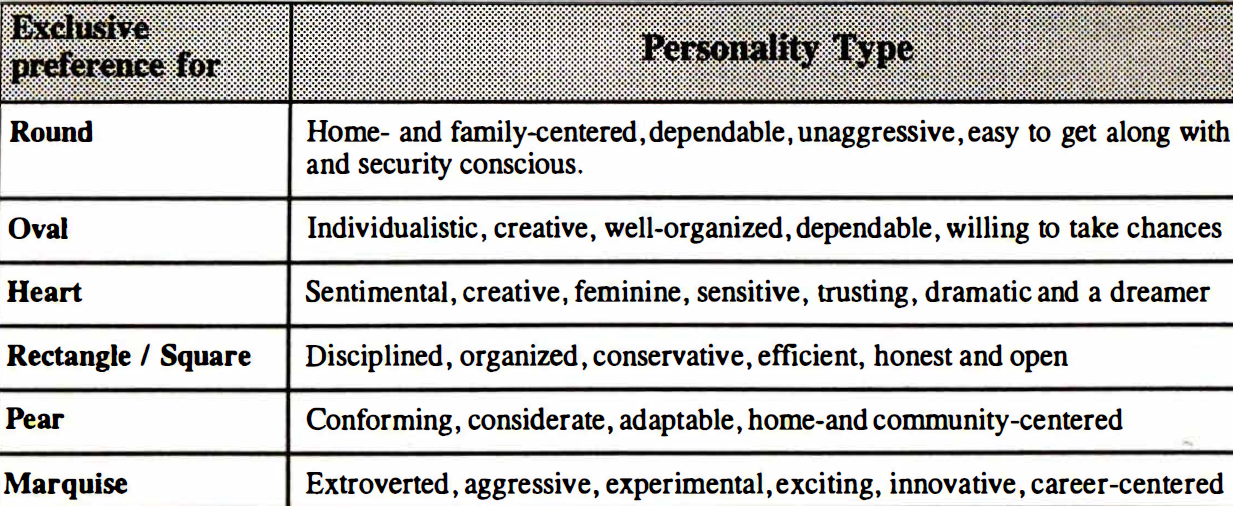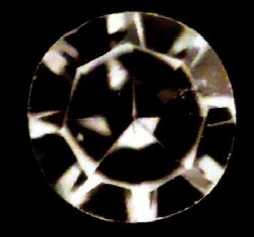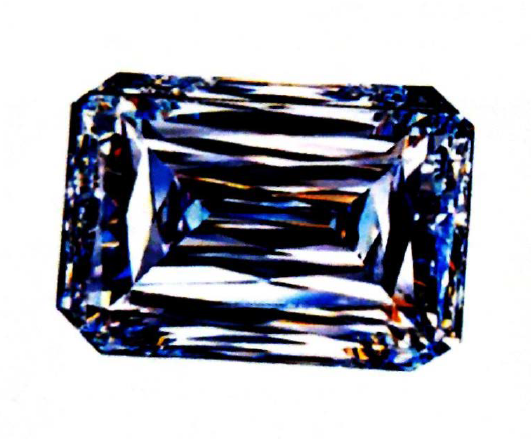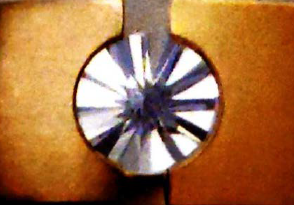Please note: From this post I will put all figures and tables in the end of each article.
The two concepts of shape and cutting style are often described by one term in the jewelry trade. For example, when a jeweler uses the term baguette, he's referring to a squarecomered, rectangular-shaped diamond with rows of step-like facets (Figure 6). If the two long sides of the baguette taper inward, it's called a tapered baguette (Figure 5 & 8). The GIA has simplified the description of diamond cutting styles by limiting them to three basic types-step cut, brilliant cut and mixed cut. These are described below:
Step Cut - Has rows of facets which are usually four-sided and elongated and parallel to the girdle. Examples include the baguette (Figure 6) and tapered baguettes (figs. 5 & 8). If step-cuts have clipped-off comers, they're called emerald cuts because emeralds are often cut this way (figs. 7 & 9). This protects the comers and provides places where prongs can secure the stone. Emerald cuts are in essence step-cut, octagonal rectangles. They tend to have more facets than baguettes. Emerald-cut diamonds are usually rectangular or square, but they can also be triangular (Figure 10).
Brilliant Cut - Has triangular-, kite-, or lozenge-shaped facets that radiate outward around the stone. Diagram 14 is an example of a heart-shaped brilliant cut with 58 facets. Four other modifications of the brilliant-cut style are the single cut, rose cut, old mine cut and the old European cut. The single cut, which has 17 or 18 facets, is used on very small diamonds (Figure 13 & 15). The jewelry trade generally refers to round diamonds with 18 facets as single cuts and to those with 58 facets as full cuts or traditional round brilliants.
In some antique jewelry and even some contemporary jewelry, you may see the rose cut (figure 16). It has triangular brilliant-style facets, a pointed dome-shaped crown, a flat base and a circular girdle outline. The rose cut, which probably originated in India, was introduced into Europe by Venetian polishers in the fifteenth century.
The old mine and old European cuts typically have 58 facets, a high crown, a small table and a large culet. Old mine cuts are cushion shaped (squarish with rounded comers and sides), whereas old European cuts are round. These older cuts were fashioned before the early 1900's when diamond saws were invented. Consequently, their proportions resemble the original rough, with the crown height similar to the pavilion depth. The modem round brilliant is cut with a lower crown, which displays more brilliance.
Gemstone pendants or earrings are occasionally cut as briolettes (Figure 17). These have a tear-drop shape, a circular cross-section and brilliant-style facets (or occasionally rectangular, step-cut style facets).
Mixed Cut - Has both step- and brilliant-cut facets. The pavilion, for example, can be step cut and the crown can be brilliant cut, but the step- and brilliant-cut facets can also be scattered over the diamond. This cut is used a lot more on transparent colored stones than on diamonds.
When you shop for diamonds, you may hear salespeople talk about Radiants, trilliants and Quadrillions-styles which have been introduced within about the last twenty-five years. To better understand what they're talking about, you can refer fo the following descriptions and photos:
Radiant - A brilliant-cut square or rectangle with clipped-off comers like the emerald cut. It has 70 facets. The Radiant (Figure 4.23) was designed and patented by Henry Grossbard of New York and is marketed by the I. Starck Co., Inc. of Chicago. It was first introduced in 1976 in Hong Kong.
Triiliant - The name used by the Royal Asscher Diamond Company of Amsterdam for a triangular brilliant cut with curved sides and a high crown. Today "trilliant" is used as a general term for any brillian-cut triangle (Figure 24)
Trielle - The trademarked name for a triangular brilliant designed by the Trillion Diamond Co., a subsidiary of LF Industries. The trielle was developed in the 1950's by Leon Pinker and patented in 1978 under the name of LF Industries in New York. Prior to 1991, the patented brand name for the Trielle was the Trillion. Now the term "trillion" is used to refer to any brilliant-cut triangle.
Quadrillion - A square diamond with 49 brilliant-style facets-21 crown facets, 24 pavilion facets and four girdle facets. The Quadrillion is designed to maximize brilliancy and minimize undesirable light leakage in square diamonds. It was patented and trademarked by Ambar Diamonds of Los Angeles in 1981. Figure 22 features a 2.05-ct Quadrillion accented by several smaller Quadrillions.
Princess Cut - A brilliant-cut square, rectangle or cushion shape, which may have from 57 to 70 facets and variable proportions (Figure 25 & 26). Like the Quadrillion, its pavilion facets widen towards the culet and narrow towards the comers to form a pattern resembling a four-pointed star.
New Cutting Styles - New styles for cutting diamonds are continuously being developed. One new brilliant-cut style is the Gabrielle, shown in figure 1 in my last article (click here), which has 105 facets. The Zoe Diamond with its 100 facets is another patented style (Figure27).
Baguettes, which are traditionally step cut, are now being made with brilliant style facets to add more brilliance. One patented brilliant-cut baguette is the Bagillion. Another unique style for rectangular diamonds is the Crisscut, which has 77 crisscrossed facets designed to increase brilliance (figs.28 & 29). It was patented in 1998.
If you're looking for a diamond with an ultramodern look, you might want to consider the Spirit Sun, also called the "Spirit Diamond." It has 32 facets with 16 triangular facets that radiate on both the crown and the pavilion, creating a bright and reflective face. It was developed by Dr. Ulrich Freiesleben of Milnster, Germany in collaboration with Bernd Munsteiner. Because of its larger facets, the Spirit Sun is ideal for displaying the color of fancy-color diamonds. Dr. Freiesleben's goal when creating the Spirit Sun was to honor the essence of the diamond by aiming for simplicity, clarity and optimal light reflection.
In next article I will discuss more details about the effect of shape & cutting style on diamond prices. Below are all the figures and tables mentioned in this article.
 |
|
Figure 1 - Personality matching different diamond shapes
|
 |
|
Figure 2 - A fantasy cut that's trademarked "Sculptaire."
|
 |
|
Figure 3 - Another fantasy cut
|
 |
|
Figure 4 - Facet arrangement of a standard round brilliant cut. Diagram reprinted with pennission from the Gemological Institute of America.
|
 |
|
Figure 5 - Step-cut tapered baguette
|
 |
|
Figure 6 & 7 - Step-cut baguette & Emerald cut
|
 |
|
Figure 8 - Tapered baguettes surrounding heart-shape diamonds.
|
 |
|
Figure 9 - Emerald-cut diamond ring (20.14 cts).
|
 |
|
Figure 10 - Emerald-cut (step-cut) triangle
|
 |
|
Figure 11 - Old mine cut, face-up view.
|
 |
|
Figure 12 - Side view of diamond in Figure 14
|
 |
|
Figure 13 - Single cut
|
 |
|
Figure 14,15 & 16 - Heart shaped brilliant cut, Single cut & Rose cut
|
 |
|
Figure 17 - Diamond necklace with a 32-carat briolette pendant.
|
 |
|
Figure 18 - Old European cut
|
 |
|
Figure 19 - Old European-cut diamonds set in earrings.
|
 |
|
Figure 20 - Oval mixed cut
|
 |
|
Figure 21 - Oval mixed cut diagram
|
 |
|
Figure 22 - The Quadrillions in this 18K gold ring give it a very brilliant look.
|
 |
|
Figure 23 - Radiant
|
 |
|
Figure 24 - Trilliant
|
 |
|
Figure 25 - Princess cut, face up
|
 |
|
Figure 26 - Princess cut, pavilion side up
|
 |
|
Figure 27 - The Zoe - a completely new cutting style.
|
 |
|
Figure 28 - A Crisscut diamond by Christopher Designs.
|
 |
|
Figure 29 - Crisscut diamonds in a ring created by Christopher Designs.
|
 |
| Figure 30 - The Spirit Sun |







































































